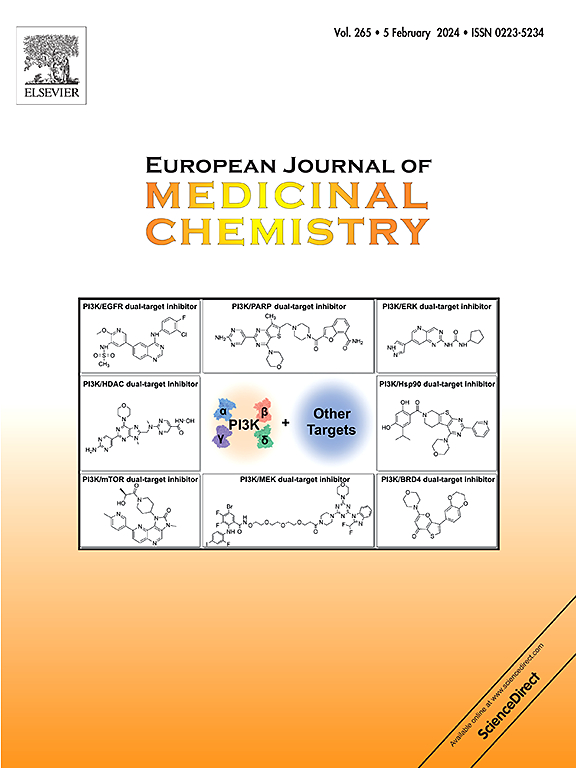Dismantling the Epigenetic Alliance: Emerging Strategies to Disrupt the PRMT5:MEP50 Complex for Cancer Therapy
IF 6
2区 医学
Q1 CHEMISTRY, MEDICINAL
引用次数: 0
Abstract
The protein arginine methyltransferase 5 (PRMT5) and its obligate cofactor MEP50 (WDR77) form a highly conserved enzymatic complex that orchestrates key epigenetic processes, including histone arginine methylation, transcriptional repression, RNA splicing, and DNA damage repair. Dysregulation of the PRMT5:MEP50 complex has been implicated in the initiation and progression of diverse cancers, where it contributes to silencing of tumor suppressor genes, enhancement of oncogenic signaling, and maintenance of stem-like phenotypes. While most therapeutic strategies have focused on catalytic inhibition of PRMT5 via S-adenosylmethionine-competitive compounds, recent insights into the structural biology of PRMT5:MEP50 have revealed the protein–protein interaction (PPI) interface as a novel and selective therapeutic target. This review provides a comprehensive analysis of the structural basis and biological significance of the PRMT5:MEP50 interaction, highlighting its role in tumorigenesis and its functional specificity across cancer types. We examine emerging therapeutic strategies aimed at disrupting this interface, including rationally designed small-molecule inhibitors and natural compounds like Sulforaphane (SFN), which selectively impair PRMT5:MEP50 function without affecting global methylation. Moreover, we explore cancer models—such as prostate cancer, mesothelioma, T-cell leukemia, and lung cancer—that exhibit dependency on PRMT5:MEP50, and discuss their response to genetic and pharmacological disruption of the complex. Finally, we outline key challenges and future directions in translating PRMT5:MEP50 PPI inhibitors into clinical settings, emphasizing the importance of biomarker-guided patient selection, combination therapy strategies, and optimization of drug pharmacokinetics. Together, these insights underscore the therapeutic promise of targeting the PRMT5:MEP50 interaction as a next-generation approach to precision epigenetic cancer therapy.

拆除表观遗传联盟:破坏PRMT5:MEP50复合体用于癌症治疗的新策略
蛋白精氨酸甲基转移酶5 (PRMT5)及其专门辅助因子MEP50 (WDR77)形成高度保守的酶复合物,协调关键的表观遗传过程,包括组蛋白精氨酸甲基化、转录抑制、RNA剪接和DNA损伤修复。PRMT5:MEP50复合物的失调与多种癌症的发生和发展有关,它有助于肿瘤抑制基因的沉默,致癌信号的增强和茎样表型的维持。虽然大多数治疗策略都集中在通过s -腺苷甲硫氨酸竞争化合物催化抑制PRMT5,但最近对PRMT5:MEP50结构生物学的研究表明,蛋白质-蛋白质相互作用(PPI)界面是一种新的选择性治疗靶点。本文综述了PRMT5与MEP50相互作用的结构基础和生物学意义,重点介绍了其在肿瘤发生中的作用及其在不同癌症类型中的功能特异性。我们研究了旨在破坏该界面的新兴治疗策略,包括合理设计的小分子抑制剂和天然化合物,如Sulforaphane (SFN),它们选择性地损害PRMT5:MEP50功能而不影响全局甲基化。此外,我们还探讨了前列腺癌、间皮瘤、t细胞白血病和肺癌等依赖于PRMT5:MEP50的癌症模型,并讨论了它们对该复合物的遗传和药理学破坏的反应。最后,我们概述了将PRMT5:MEP50 PPI抑制剂转化为临床环境的关键挑战和未来方向,强调了生物标志物引导的患者选择,联合治疗策略和药物药代动力学优化的重要性。总之,这些见解强调了靶向PRMT5:MEP50相互作用作为下一代精确表观遗传癌症治疗方法的治疗前景。
本文章由计算机程序翻译,如有差异,请以英文原文为准。
求助全文
约1分钟内获得全文
求助全文
来源期刊
CiteScore
11.70
自引率
9.00%
发文量
863
审稿时长
29 days
期刊介绍:
The European Journal of Medicinal Chemistry is a global journal that publishes studies on all aspects of medicinal chemistry. It provides a medium for publication of original papers and also welcomes critical review papers.
A typical paper would report on the organic synthesis, characterization and pharmacological evaluation of compounds. Other topics of interest are drug design, QSAR, molecular modeling, drug-receptor interactions, molecular aspects of drug metabolism, prodrug synthesis and drug targeting. The journal expects manuscripts to present the rational for a study, provide insight into the design of compounds or understanding of mechanism, or clarify the targets.

 求助内容:
求助内容: 应助结果提醒方式:
应助结果提醒方式:


